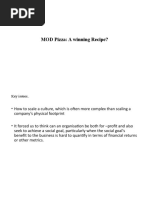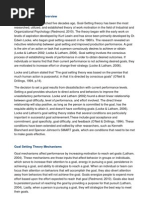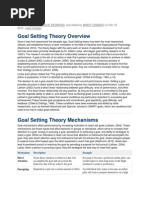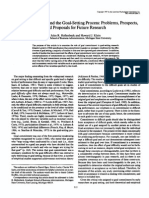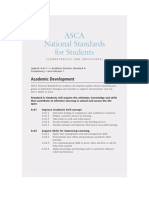0 ratings0% found this document useful (0 votes)
53 viewsThe Theory of Rests On The Belief That Life Is A Process of Goal-Oriented Action (Locke & Latham, 1990, 2002)
The Theory of Rests On The Belief That Life Is A Process of Goal-Oriented Action (Locke & Latham, 1990, 2002)
Uploaded by
Jonas valerioGoal setting theory proposes that setting specific, difficult goals leads to higher performance. However, critics argue that the theory ignores several important factors. It does not consider the effects of goal setting over different time horizons, may advocate goals that are too narrow or specific, and can cause problems if too many goals are assigned simultaneously. Additionally, unexpected undesirable consequences for employees can occur if assigned goals are not reached. More research is still needed to fully understand how goal setting impacts performance in organizational settings.
Copyright:
© All Rights Reserved
Available Formats
Download as XLSX, PDF, TXT or read online from Scribd
The Theory of Rests On The Belief That Life Is A Process of Goal-Oriented Action (Locke & Latham, 1990, 2002)
The Theory of Rests On The Belief That Life Is A Process of Goal-Oriented Action (Locke & Latham, 1990, 2002)
Uploaded by
Jonas valerio0 ratings0% found this document useful (0 votes)
53 views12 pagesGoal setting theory proposes that setting specific, difficult goals leads to higher performance. However, critics argue that the theory ignores several important factors. It does not consider the effects of goal setting over different time horizons, may advocate goals that are too narrow or specific, and can cause problems if too many goals are assigned simultaneously. Additionally, unexpected undesirable consequences for employees can occur if assigned goals are not reached. More research is still needed to fully understand how goal setting impacts performance in organizational settings.
Original Title
Goals
Copyright
© © All Rights Reserved
Available Formats
XLSX, PDF, TXT or read online from Scribd
Share this document
Did you find this document useful?
Is this content inappropriate?
Goal setting theory proposes that setting specific, difficult goals leads to higher performance. However, critics argue that the theory ignores several important factors. It does not consider the effects of goal setting over different time horizons, may advocate goals that are too narrow or specific, and can cause problems if too many goals are assigned simultaneously. Additionally, unexpected undesirable consequences for employees can occur if assigned goals are not reached. More research is still needed to fully understand how goal setting impacts performance in organizational settings.
Copyright:
© All Rights Reserved
Available Formats
Download as XLSX, PDF, TXT or read online from Scribd
Download as xlsx, pdf, or txt
0 ratings0% found this document useful (0 votes)
53 views12 pagesThe Theory of Rests On The Belief That Life Is A Process of Goal-Oriented Action (Locke & Latham, 1990, 2002)
The Theory of Rests On The Belief That Life Is A Process of Goal-Oriented Action (Locke & Latham, 1990, 2002)
Uploaded by
Jonas valerioGoal setting theory proposes that setting specific, difficult goals leads to higher performance. However, critics argue that the theory ignores several important factors. It does not consider the effects of goal setting over different time horizons, may advocate goals that are too narrow or specific, and can cause problems if too many goals are assigned simultaneously. Additionally, unexpected undesirable consequences for employees can occur if assigned goals are not reached. More research is still needed to fully understand how goal setting impacts performance in organizational settings.
Copyright:
© All Rights Reserved
Available Formats
Download as XLSX, PDF, TXT or read online from Scribd
Download as xlsx, pdf, or txt
You are on page 1of 12
Theory Criticisms
Critics have complained
that goal setting theory has been
1 overprescribed (Ordoñez, et al.,
2009). Goal setting has been described
· The theory of goal setting rests on as being effective for any
the belief that life is a process of goal- type of task in any type of setting, but
oriented action (Locke & Latham, 1990, this may not actually be the
2002) case in organizations
The theory has been criticized for
advocating goals that are
· Goals can be defined as a too specific or too narrow (Ordoñez, et
al., 2009). Specific goals
2 result that individuals try to can cause individuals to spend too
accomplish (Locke,Shaw, Saari, & much time focusing on them
Latham, 1981 to the detriment of other important
organizational behaviors,
such as innovation, creativity, and
flexibility. More research is
needed to uncover the influences on
level of goal specificity on
performance level. Staw and Boettger
(1990) found that goals
that are too narrow can lower
performance levels on assigned
tasks
Critics of goal setting theory have
argued that most research
In organizations, people are has ignored a time horizon when
motivated to direct their attention setting goals (Ordoñez, et al.,
toward and achieve goals. Goals 2009). For example, if short-term goals
3 are set, then managers will
have both an internal and an
most often only focus on short-term
external aspect for individuals. performance at the expense
Internally, goals are desired ends of long-term performance. Cheng,
of achievement; externally, goals Subramanyam, and Zhang
refer employees to an object or to (2005) found that focusing on meeting
a condition being sought, such as only quarterly perfor
-
a performance level, a sale to a mance goals can result in firms not
customer, or a promotion (Locke, investing in long-term research
1996; Locke & Latham, 2006 and development efforts
· The positive relationship
between goal setting and task
performance is one of the most
4 replicable findings in the
management and organization
literature (Locke, Shaw,Saari, &
Latham, 1981)
· According to goal setting
theory, the highest levels of
performance are usually reached
when goals are both difficult and
specific. The more difficult a goal
assigned to someone, the greater
the resulting performance level.
5 When a specific, difficult goal is
set for employees, then goal
attainment provides those Critics have argued that the theory has
ignored the problems
employees with an objective, caused by too many goals being
unambiguous basis for evaluating assigned for task performance
the effectiveness of their (Ordoñez, et al., 2009). Shah,
performance (Locke & Latham, Friedman, and Kruglanski (2002)
found that individuals tend to focus
2006) only on one goal at a time
when assigned multiple goals
simultaneously
Goals influence performance levels by
affecting the direction
6 of action, the degree of effort exerted,
and the persistence of
action over time.
Finally, critics of the theory contend
that there can be unexpected
undesirable consequences for
7 Performance has been shown to be employees when assigned
higher when goals are goals are not reached (Ordoñez, et al.,
higher, when people are committed to 2009). For example, when
reaching the goal, and employees don’t reach goals they can
when people possess the required have lower attitudes,
ability and knowledge to achieve lower self-perceptions, and lower self-
that goal (Locke, 1968; Locke & Latham, efficacy beliefs (Galinsky,
2006) Mussweiler, & Medvec, 2002;
Mussweiler & Strack, 2000
To improve performance, help ensure
8 that individuals are
committed to their goals (Locke,
Latham, & Erez, 1988).
Goal setting has been shown to result in
higher levels of per
9 formance when goals are either
assigned to individuals or when
individuals are allowed to set goals for
themselves (Hollenbeck
& Brief, 1987).
Goal setting results in the highest
performance levels when
10 people are given feedback about how
well they are performing
(Locke, 1967).
People with high self-efficacy set higher
11 goals for themselves
than do people with low self-efficacy
(Locke & Latham, 2006).
Goal setting effects may be weaker
depending on task complexity (Earley,
12 1985; Jackson & Zedeck, 1982; Wood,
Mento, &
Locke, 1987).
Goal setting against organizations
Goal setting too specific against other
important organizational behaviors,
such as innovation, creativity, and
flexibility.
Critics have argued that there may
not be a positive, linear
relationship between goal difficulty
and task performance as
advocated by the theory. If goals are
too challenging, then problems
undesired organizational outcomes caused by too many goals being
can occur, such as unethical assigned for task performance against
behavior and unnecessary risk taking individuals tend to focus only on one
in order to accomplish goals goal at a time
(Larrick, Heath, & Wu, 2009; Ordoñez, when assigned multiple goals
et al., 2009). simultaneously
unexpected undesirable
consequences for employees when
assigned
goals are not reached
You might also like
- MOD Pizza: A Winning Recipe?Document13 pagesMOD Pizza: A Winning Recipe?RahulMotipalleNo ratings yet
- Impulsive Buying MotivationDocument9 pagesImpulsive Buying MotivationrizkyandhikaNo ratings yet
- Work MotivationDocument7 pagesWork MotivationEmman TagubaNo ratings yet
- Performance Management PolicyDocument15 pagesPerformance Management PolicyAbhinandan100% (2)
- New Directions in Goal-Setting Theory PDFDocument6 pagesNew Directions in Goal-Setting Theory PDFcperkgoNo ratings yet
- Setting SMART Goals TheoryDocument27 pagesSetting SMART Goals TheoryGeorgi Ivanov100% (6)
- Self-Regulation Through Goal SettingDocument36 pagesSelf-Regulation Through Goal SettingFahad MehmoodNo ratings yet
- Chap.3.2. What Is Goal Setting and How To Do It WellDocument18 pagesChap.3.2. What Is Goal Setting and How To Do It WellJennyNo ratings yet
- Lawlor 2012 Application of SMART Goals and Student LearningDocument9 pagesLawlor 2012 Application of SMART Goals and Student LearningKunsovann KhanNo ratings yet
- Aubé & Rousseau 2005Document16 pagesAubé & Rousseau 2005IolandaLoreiroNo ratings yet
- Panorama Student Survey Resource Kit - Panorama EducationDocument16 pagesPanorama Student Survey Resource Kit - Panorama EducationBarry AsdaniNo ratings yet
- MM Flexcon PistonDocument12 pagesMM Flexcon Pistonapi-33770469580% (5)
- Performance Management at StartupsDocument7 pagesPerformance Management at StartupsLaura SaenzNo ratings yet
- Goal Setting Theory: Management and Organization TheoryDocument17 pagesGoal Setting Theory: Management and Organization TheoryJonas valerioNo ratings yet
- Obsessive Passion, Competence, and Performance in A Project Management ContextDocument39 pagesObsessive Passion, Competence, and Performance in A Project Management ContextfedorNo ratings yet
- Goal Setting TheoryDocument9 pagesGoal Setting TheoryNysha GangadharanNo ratings yet
- New Directions in Goal-Setting TheoryDocument6 pagesNew Directions in Goal-Setting TheorycperkgoNo ratings yet
- New Directions in Goal-SettingDocument4 pagesNew Directions in Goal-SettingSzékely TimeaNo ratings yet
- What Is GoalDocument6 pagesWhat Is Goal郑纹薪No ratings yet
- Obsessive Passion, Competence, and Performance in A Project Management ContextDocument12 pagesObsessive Passion, Competence, and Performance in A Project Management ContextpralayeshNo ratings yet
- Essay - Final VersionDocument10 pagesEssay - Final VersionTrương Hoài NamNo ratings yet
- Assessment Preparation - Q1 - Tutorial Week 6Document22 pagesAssessment Preparation - Q1 - Tutorial Week 6Bop Bi BauNo ratings yet
- Goal Setting For Peak Performance: Daniel Gould, Michigan State UniversityDocument19 pagesGoal Setting For Peak Performance: Daniel Gould, Michigan State UniversityTamara AlejandraNo ratings yet
- finals 2 Setting-Goals-for-SuccessDocument48 pagesfinals 2 Setting-Goals-for-SuccessjbenedictaNo ratings yet
- fpsyg-12-704790Document17 pagesfpsyg-12-704790Manuel AranagaNo ratings yet
- Goal SettingDocument23 pagesGoal SettingManish Soni100% (1)
- Felix Kwame Opoku 8Document22 pagesFelix Kwame Opoku 8profbruceNo ratings yet
- Ilide - Info Setting Smart Goals Theory PRDocument27 pagesIlide - Info Setting Smart Goals Theory PRMary Queen DiolaglaOLFANo ratings yet
- Goal Setting: S.M.A.R.T GoalsDocument7 pagesGoal Setting: S.M.A.R.T GoalsNitin SharmaNo ratings yet
- Understanding The SelfDocument13 pagesUnderstanding The SelfJoshua Lander Soquita Cadayona100% (1)
- Goal Setting - AssgnDocument4 pagesGoal Setting - AssgnLuke MpaselaNo ratings yet
- Understanding The Self: The Importance of GoalsDocument2 pagesUnderstanding The Self: The Importance of GoalsClara GabatNo ratings yet
- Theory of Goal Setting and Task MotivationDocument4 pagesTheory of Goal Setting and Task Motivationlyleemberga73No ratings yet
- Setting Goals For SuccessDocument48 pagesSetting Goals For SuccessXtian Xistian100% (1)
- A Theory of Goal Setting and Task PerforDocument37 pagesA Theory of Goal Setting and Task PerforDaphnie MonteverdeNo ratings yet
- Welsh, D. T., & Ordóñez, L. D. (2014) PDFDocument12 pagesWelsh, D. T., & Ordóñez, L. D. (2014) PDFMert GürlekNo ratings yet
- Adie 2008Document21 pagesAdie 200820030195No ratings yet
- Literature Review of ProjectssssDocument17 pagesLiterature Review of ProjectssssTANU ANo ratings yet
- Goal SettingDocument9 pagesGoal SettingNguyễn Tiến ĐứcNo ratings yet
- Goal Setting Theory What It Implies For Strategic Human Resource Development (#239425) - 207888 2015 PDFDocument8 pagesGoal Setting Theory What It Implies For Strategic Human Resource Development (#239425) - 207888 2015 PDFRAKHI CHAUHANNo ratings yet
- 06 - Locke & Latham 2005 GST InductiveDocument24 pages06 - Locke & Latham 2005 GST InductiveCate MasilunganNo ratings yet
- Lunenburg, Fred C. Goal-Setting Theoryof Motivation IJMBA V15 N1 2011Document6 pagesLunenburg, Fred C. Goal-Setting Theoryof Motivation IJMBA V15 N1 2011Chirag Sheth0% (1)
- Locke - Goal Setting PDFDocument28 pagesLocke - Goal Setting PDFcperkgoNo ratings yet
- An Exploratory Study of Goal Setting in Theory and Practice: A Motivational Technique That Works?Document17 pagesAn Exploratory Study of Goal Setting in Theory and Practice: A Motivational Technique That Works?Yvette HouseNo ratings yet
- The Effect of Goal Setting On Group Performance: A Meta-AnalysisDocument16 pagesThe Effect of Goal Setting On Group Performance: A Meta-AnalysisasdasdlknNo ratings yet
- Goal Commitment Process DocumentDocument9 pagesGoal Commitment Process DocumentMahbubRiyadNo ratings yet
- Schunk, 2001. Self-Regulation Through Goal SettingDocument4 pagesSchunk, 2001. Self-Regulation Through Goal SettingNani Maciel100% (1)
- Thompson (2009) and Bird (1988)Document3 pagesThompson (2009) and Bird (1988)Yoel ChristopherNo ratings yet
- Goal Setting-Building A Practically Useful Theory of Goal Setting and Task MotivationDocument26 pagesGoal Setting-Building A Practically Useful Theory of Goal Setting and Task MotivationNitin SharmaNo ratings yet
- Implementation Intention Depends On The Number of GoalsDocument17 pagesImplementation Intention Depends On The Number of GoalslutenkNo ratings yet
- Self Esteem&Task PerformaceDocument18 pagesSelf Esteem&Task Performacecynthiawei010604No ratings yet
- Fewer The Better number-of-goals-JMR PDFDocument14 pagesFewer The Better number-of-goals-JMR PDFShubham MehtaNo ratings yet
- OT NEW CH 3 NewDocument13 pagesOT NEW CH 3 Newdine62611No ratings yet
- Setting Goals For Success UTS ReportingDocument3 pagesSetting Goals For Success UTS ReportingLoveyysolonNo ratings yet
- The Role of Goal Clarity, Team Commitment and Support For Innovation in Team EffectivenessDocument26 pagesThe Role of Goal Clarity, Team Commitment and Support For Innovation in Team EffectivenessZarbakhat AzamNo ratings yet
- Students First Name Management and Organization in Global EnvironmentDocument6 pagesStudents First Name Management and Organization in Global EnvironmentKENNo ratings yet
- Hbo Theory ReportDocument15 pagesHbo Theory ReportJelah Chiara IINo ratings yet
- Big Five and Organizational Commitment - The Case of Turkish Construction ProfessionalsDocument9 pagesBig Five and Organizational Commitment - The Case of Turkish Construction Professionalsf100200164No ratings yet
- Keller (2017) A Longitudinal Study of The Individual Characteristics of Effective R&D Project Team LeadersDocument14 pagesKeller (2017) A Longitudinal Study of The Individual Characteristics of Effective R&D Project Team LeadersGislayneNo ratings yet
- Running Head: Article Review 1Document5 pagesRunning Head: Article Review 1johnNo ratings yet
- Epton Et Al. (2017) Unique Effe___Setting on Behavior ChangeDocument116 pagesEpton Et Al. (2017) Unique Effe___Setting on Behavior ChangestettenfeldNo ratings yet
- Team Learning in Projects: Theory and PracticeFrom EverandTeam Learning in Projects: Theory and PracticeNo ratings yet
- Measure What Matters - Summarized for Busy People: How Google, Bono, and the Gates Foundation Rock the World with OKRs: Based on the Book by John DoerrFrom EverandMeasure What Matters - Summarized for Busy People: How Google, Bono, and the Gates Foundation Rock the World with OKRs: Based on the Book by John DoerrNo ratings yet
- Summarized for Busy People - Measure What Matters: How Google, Bono, and the Gates Foundation Rock the World with OKRsFrom EverandSummarized for Busy People - Measure What Matters: How Google, Bono, and the Gates Foundation Rock the World with OKRsNo ratings yet
- Honor or Horror? A History of Hazing in The PhilippinesDocument9 pagesHonor or Horror? A History of Hazing in The PhilippinesJonas valerioNo ratings yet
- Tradition of HazingDocument8 pagesTradition of HazingJonas valerioNo ratings yet
- Presented By: MR Jason M BaswelDocument21 pagesPresented By: MR Jason M BaswelJonas valerioNo ratings yet
- Hazing in The PhilippinesDocument24 pagesHazing in The PhilippinesJonas valerioNo ratings yet
- The Tradition of Hazing in The Philippine Military by MR Jason M BaswelDocument1 pageThe Tradition of Hazing in The Philippine Military by MR Jason M BaswelJonas valerioNo ratings yet
- Employee-Labor Management RelationsDocument5 pagesEmployee-Labor Management RelationsJonas valerioNo ratings yet
- Case Study: Bunaken Case: A. Analysis of The ProblemDocument2 pagesCase Study: Bunaken Case: A. Analysis of The ProblemJonas valerioNo ratings yet
- Case Insigths For Submission Sir JeffDocument1 pageCase Insigths For Submission Sir JeffJonas valerioNo ratings yet
- Emotional Intelligence Activity Original-1Document40 pagesEmotional Intelligence Activity Original-1Rahul SekharNo ratings yet
- 4 Enhance Self-Management SkillsDocument42 pages4 Enhance Self-Management SkillsEsperanza TayaoNo ratings yet
- Understanding The Self (Reviewer)Document20 pagesUnderstanding The Self (Reviewer)Mary Rose Ann Beloso CortezanoNo ratings yet
- Research Proposal Aging and Work Motivation: Mr. Adil EjazDocument9 pagesResearch Proposal Aging and Work Motivation: Mr. Adil EjazSardar Adil DogarNo ratings yet
- 2022 Realtor Business Plan Free Template - RealOffice360 Real Estate CRMDocument21 pages2022 Realtor Business Plan Free Template - RealOffice360 Real Estate CRMChrstina GirmaNo ratings yet
- Chapter One Concept of LeadershipDocument20 pagesChapter One Concept of LeadershipAse SharewNo ratings yet
- Management, 13e (Robbins)Document16 pagesManagement, 13e (Robbins)Hoàng NgânNo ratings yet
- HBR 4 Distractions That Derail Meetings 230519Document4 pagesHBR 4 Distractions That Derail Meetings 230519MarianaNo ratings yet
- Worksheet Motivation - Part 2Document13 pagesWorksheet Motivation - Part 2jashuramuNo ratings yet
- The Relationship Between Financial Literacy Reporting and Profitability of Small and Medium Enterprises in Bayelsa StateDocument15 pagesThe Relationship Between Financial Literacy Reporting and Profitability of Small and Medium Enterprises in Bayelsa StateEditor IJTSRDNo ratings yet
- Learning Journal Unit 7Document2 pagesLearning Journal Unit 7AbdulHadi Hassan RaikwalNo ratings yet
- HRM Final Report On NAYATELDocument17 pagesHRM Final Report On NAYATELfaisalNo ratings yet
- Coaching Induction PlanDocument2 pagesCoaching Induction Planapi-497292290No ratings yet
- Stage 2 Physical Education Subject Outline For Teaching in 2020Document25 pagesStage 2 Physical Education Subject Outline For Teaching in 2020api-346515764No ratings yet
- Universal Design For Learning UdlDocument1 pageUniversal Design For Learning Udlapi-555048591No ratings yet
- Ziglar Goals Journal SampleDocument4 pagesZiglar Goals Journal SampleMycroft Samuel100% (4)
- Employee Behaviour and InfluencesDocument18 pagesEmployee Behaviour and InfluencesFabeena50% (4)
- Goal Setting and Achievement Strategies for SuccessDocument7 pagesGoal Setting and Achievement Strategies for Successshsa123553No ratings yet
- Training PlanDocument3 pagesTraining Planapi-3695814100% (2)
- Asca National Standards For Students: Academic DevelopmentDocument6 pagesAsca National Standards For Students: Academic Developmentapi-130253013No ratings yet
- Promoting Best Practice in Behaviour-Based Safety: Symposium Series No. 148 © 2001 IchemeDocument14 pagesPromoting Best Practice in Behaviour-Based Safety: Symposium Series No. 148 © 2001 Icheme@12No ratings yet
- Principles of Management: Dr. Khalil-ur-Rahmen Khoumbati ProfessorDocument29 pagesPrinciples of Management: Dr. Khalil-ur-Rahmen Khoumbati ProfessorSyed HamzaNo ratings yet
- Case ManagementDocument11 pagesCase ManagementClarissa KennedyNo ratings yet
- Module 2 NC I Working With Others ForTrainingOnlyDocument75 pagesModule 2 NC I Working With Others ForTrainingOnlyRey DanaoNo ratings yet
